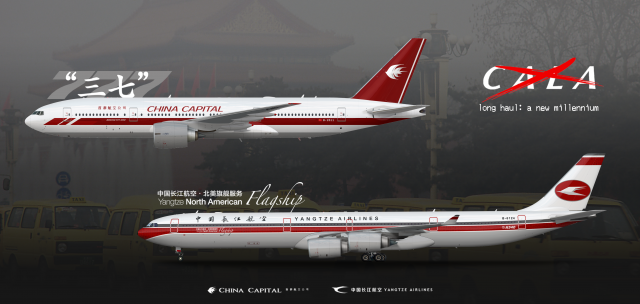
Chapter 3: 777 & A340 (2000)
- Owner: J.C (View all images and albums)
- Uploaded: Jul 17 2023 04:22 PM
- Views: 502
- Album CALA: The Final Days

Chapter 3: Long Haul. The New Millenium.
As part of the 1988 split, both China Capital and Yangtze Airlines had to design new brand identities. The new flag carrier, China Capital, went with a bold and modern design that catered to international travelers by emphasizing an English language title on the aircraft. The carrier paired a sophisticated crimson with a sharp and geometric cheatline across the fuselage. The carrier adopted the stately and elegant red-crowned crane as an inspiration and designers stylized the bird into the brand's logo. Yangtze Airlines, on the other hand, went in a drastically more conservative direction with its brand identity. Their livery sported gray and red cheatlines over a light gray belly, with large Chinese titles written in calligraphy completing the look. The logo of Yangtze Airlines was a swallow geometrically stylized to represent the Yangtze River Delta and its convergence of rivers.
The two airlines found their footing quite quickly even though they now wore different proverbial shoes. By the early 1990s, Yangtze Airlines carved out a spot in the international market, connecting China and North America with daily services between Shanghai and Los Angeles, New York, and Toronto, mostly with MD-11 and Boeing 767-200ERs. Still, this growth paled in comparison to China Capital’s early endeavors which made it a clear winner when comparing the two carriers. The carrier built a vast European and Asian international network from their Beijing hub with prestigious Boeing 747 and MD-11CF jets, with fast, frequent, and comfortable services. China Capital also controlled about 65% of domestic air traffic, mostly in Northern and Western China, leaving Yangtze with the Southern and Central routes.
In 1995, China Capital and Yangtze Airlines both made huge orders expanding their long-haul fleet. China Capital, a dedicated Boeing customer by this point, went with the revolutionary 777-200, ordering 12 of the type. Delivered in 1998, China Capital’s “San Qi” would complement their famed 747 fleets and enable quiet, comfortable, and expedient flights to Europe and popular destinations in Asia. The order also relegated older MD-11CFs to operate high-demand domestic flights which improved the carrier’s domestic operations greatly. Yangtze also looked to Boeing, going as far as to purchase 4 Boeing 767-300ERs intended for long-haul services and negotiating for their own 747s to compete directly with China Capital. However, Airbus, looking to expand its presence in the Chinese market, offered the airline a packaged deal of 35 A320s, 10 A340-300s, and 5 A340-600s at a steep discount, derailing further talks with Boeing, and scoring the largest order in Yangtze’s history at the time. To leverage their advantage in North America, Yangtze named their A340-600 fleet the Yangtze North American Flagship and used them exclusively on flagship direct flights from Shanghai to Los Angeles, New York, San Francisco, and Toronto with a brief stint covering flights to Washington D.C. The 767-300ERs, now bumped out of their trans-pacific role, combined with the new A340-300s to overhaul Yangtze’s medium-haul network. China Capital’s “San Qi” and Yangtze’s “North American Flagship” were some of the most luxurious jets in the skies at the time of their introduction in 1998, featuring novel amenities like on-demand video entertainment, satellite telephones, and power outlets. Armed with some of the best widebody jets in the business and upscale service, it was clear that the two airlines’ competition was increasing rather than decreasing as their new identities solidified. The new millennium looked to be harboring an arms race for the fate of the Chinese air sector.
I love this so much, it's brilliant.
Just one small pointer with the lore. The A340-600 didn't enter service until 2002.
The A340-600 didn't enter service until 2002.
epic failure jc!!!!
Wow great lore love it lots. It's cool how diverse branding identities were in this time period this CALA series really displays that and it's cool

 Sign In
Sign In Create Account
Create Account














cum